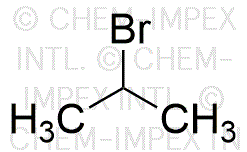2-Bromopropane is widely utilized in research focused on:
- Solvent Applications: Commonly used as a solvent in organic synthesis, 2-bromopropane effectively dissolves a variety of organic compounds, making it invaluable in laboratories for chemical reactions.
- Intermediate in Synthesis: It serves as a key intermediate in the production of pharmaceuticals and agrochemicals, facilitating the creation of complex molecules with specific biological activities.
- Reagent in Organic Chemistry: This compound is often employed as a reagent in various organic reactions, such as nucleophilic substitutions, which are critical for developing new chemical entities.
- Extraction Processes: In the extraction of natural products, 2-bromopropane is utilized due to its ability to selectively extract certain compounds, enhancing the efficiency of the extraction process.
- Research in Material Science: It is also explored in material science for developing new polymers and materials, where its unique properties can lead to innovations in product design and functionality.
Información general
Propiedades
Seguridad y normativas
Aplicaciones
2-Bromopropane is widely utilized in research focused on:
- Solvent Applications: Commonly used as a solvent in organic synthesis, 2-bromopropane effectively dissolves a variety of organic compounds, making it invaluable in laboratories for chemical reactions.
- Intermediate in Synthesis: It serves as a key intermediate in the production of pharmaceuticals and agrochemicals, facilitating the creation of complex molecules with specific biological activities.
- Reagent in Organic Chemistry: This compound is often employed as a reagent in various organic reactions, such as nucleophilic substitutions, which are critical for developing new chemical entities.
- Extraction Processes: In the extraction of natural products, 2-bromopropane is utilized due to its ability to selectively extract certain compounds, enhancing the efficiency of the extraction process.
- Research in Material Science: It is also explored in material science for developing new polymers and materials, where its unique properties can lead to innovations in product design and functionality.
Documentos
Hojas de datos de seguridad (HDS)
La SDS proporciona información de seguridad completa sobre la manipulación, el almacenamiento y la eliminación del producto.
Especificación del producto (PS)
La PS proporciona un desglose completo de las propiedades del producto, incluida la composición química, el estado físico, la pureza y los requisitos de almacenamiento. También detalla los rangos de calidad aceptables y las aplicaciones previstas del producto.
Certificados de análisis (COA)
Busque certificados de análisis (COA) ingresando el número de lote del producto. Los números de lote y de partida se pueden encontrar en la etiqueta de un producto después de las palabras "Lote" o "Lote".
Número de catálogo
Número de lote/lote
Certificados de origen (COO)
Este certificado de origen confirma el país en el que se fabricó el producto y también detalla los materiales y componentes utilizados en él y si se deriva de fuentes naturales, sintéticas u otras fuentes específicas. Este certificado puede ser necesario para cumplir con las normativas aduaneras, comerciales y regulatorias.
Número de catálogo
Número de lote/lote
Hojas de datos de seguridad (HDS)
La SDS proporciona información de seguridad completa sobre la manipulación, el almacenamiento y la eliminación del producto.
DownloadEspecificación del producto (PS)
La PS proporciona un desglose completo de las propiedades del producto, incluida la composición química, el estado físico, la pureza y los requisitos de almacenamiento. También detalla los rangos de calidad aceptables y las aplicaciones previstas del producto.
DownloadCertificados de análisis (COA)
Busque certificados de análisis (COA) ingresando el número de lote del producto. Los números de lote y de partida se pueden encontrar en la etiqueta de un producto después de las palabras "Lote" o "Lote".
Número de catálogo
Número de lote/lote
Certificados de origen (COO)
Este certificado de origen confirma el país en el que se fabricó el producto y también detalla los materiales y componentes utilizados en él y si se deriva de fuentes naturales, sintéticas u otras fuentes específicas. Este certificado puede ser necesario para cumplir con las normativas aduaneras, comerciales y regulatorias.


